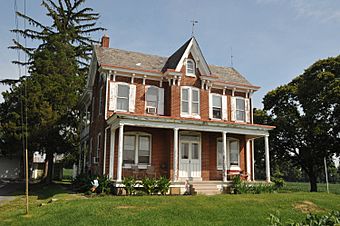Boyer–Mertz Farm facts for kids
Quick facts for kids |
|
|
Boyer–Mertz Farm
|
|

Boyer–Mertz Farm, August 2014
|
|
| Location | Jct. of Noble St. and Bastian Rd., Maxatawny Township, Pennsylvania |
|---|---|
| Area | 102 acres (41 ha) |
| Built | 1871, 1905 |
| Architectural style | Pennsylvania bank barn |
| MPS | Farms in Berks County MPS |
| NRHP reference No. | 92000937 |
| Added to NRHP | September 9, 1992 |
The Boyer–Mertz Farm is a very old and special farm in Maxatawny Township, Pennsylvania. It's also known as Angstadt Farm. This farm is so important that it's listed as a national historic place. It was added to the National Register of Historic Places in 1992.
Farm History: Who Owned It?
The story of the Boyer-Mertz Farm began in 1800. That year, John Coates received official permission to own this land. This permission came from John Penn and Richard Penn. They were descendants of William Penn, who founded Pennsylvania.
In 1802, Phillip Mertz took ownership of the farm. The Mertz family owned the land for many years. Then, in 1845, they sold it to Solomon and Benneville Boyer. Benneville Boyer and his wife, Mary, eventually owned the farm by themselves.
In 1871, the Boyers made big improvements to the farm. They built a large barn. You can still see the date "1871" on the barn today. Historians believe the Boyers also built a brick house for workers and a stone summer kitchen.
The farm returned to the Mertz family in 1901. They were responsible for building the main farmhouse. This house was built in 1905. The Mertzes owned the farm until 1941. After that, it was sold a few more times. In 1945, Kuney and Arlene Angstadt bought it. Later, in 1972, they transferred it to Ernest Angstadt.
The Boyer-Mertz Farm was officially listed on the National Register of Historic Places in 1992. This means it's a very important historical site. In 2017, a strong storm damaged part of the farm. The wind was so powerful it lifted the roof off one of the barns.
What Buildings Are on the Farm?
The Boyer-Mertz Farm has many interesting old buildings and structures. These are called "contributing" because they add to the farm's historical importance.
Some of the main buildings include:
- A two-and-a-half-story brick house for workers, built in 1871.
- A large brick-and-wood Pennsylvania bank barn, also built in 1871. A bank barn is built into a hillside, so you can enter different levels from the ground.
- A two-and-a-half-story brick farmhouse, built in 1905.
Other buildings on the farm are:
- A stone summer kitchen, built around 1850.
- Three sheds for wagons or buggies.
- A carriage shop.
- A privy (an old outdoor toilet).
The farm also has several important structures:
- A pumphouse.
- Four chicken houses.
- Five stone cisterns (tanks for collecting rainwater).
- A corn crib (a building for storing corn).



